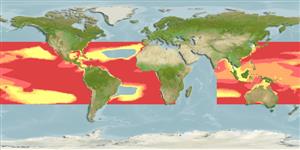Common names from other countries
Classification / Names
Nombres comunes | Sinónimos | Catalog of Fishes(Género, Especie) | ITIS | CoL | WoRMS | Cloffa
>
Scombriformes (Mackerels) >
Caristiidae (Manefishes)
Etymology: Paracaristius: Name from the Greek 'para' meaning around or near and Caristius.; nudarcus: Name from Latin adjective nudus meaning 'bare' or 'naked' and the noun arcus for arch, referring to the absence of fingerlike papillae on the dorsal surface of the hyoid arch (Ref. 87954).
Environment: milieu / climate zone / depth range / distribution range
Ecología
marino; rango de profundidad 1 - 1800 m (Ref. 87954). Tropical; 40°N - 35°S (Ref. 87954)
Pacific, Indian and Atlantic Ocean: specimens were collected from the eastern and western Pacific Ocean, as well as the southern Indian and tropical Atlantic oceans.
Tamaño / Peso / Age
Maturity: Lm ? range ? - ? cm
Max length : 22.3 cm SL macho / no sexado; (Ref. 87954)
Short description
Claves de identificación | Morfología | Morfometría
Radios blandos dorsales (total) : 27 - 31; Radios blandos anales: 17 - 20; Vértebra: 33 - 37. This species is distinguished from P. nemorosus and P. aquilus by the absence of fingerlike papillae along the dorsal margin of the hyoid arch and at the interhyal-posterior ceratohyal articulation and by having fewer dorsal-fin rays, 27-31 (vs. 30-33 in P. nemorosus and P. aquilus); has more anal-fin rays, 17-20 (vs. 15-18); differs from P. maderensis by the position of the dorsal-fin origin which is above orbit (vs. posterior to orbit in P. maderensis), single row arrangement of the jaw teeth except near symphyses (vs. multiple rows in P. maderensis) (Ref. 87954).
Life cycle and mating behavior
Maturities | Reproducción | Spawnings | Egg(s) | Fecundities | Larva
Stevenson, D.E. and C.P. Kenaley, 2011. Revision of the manefish genus Paracaristius (Teleostei: Percomorpha: Caristiidae), with descriptions of a new genus and three new species. Copeia 2011(3):385-399 (Ref. 87954)
IUCN Red List Status (Ref. 130435)
CITES (Ref. 128078)
Not Evaluated
Threat to humans
Harmless
Human uses
Herramientas
Special reports
Download XML
Fuentes de Internet
Estimates based on models
Preferred temperature (Ref.
115969): 5.3 - 15.6, mean 9.4 (based on 978 cells).
Phylogenetic diversity index (Ref.
82804): PD
50 = 0.5625 [Uniqueness, from 0.5 = low to 2.0 = high].
Bayesian length-weight: a=0.01995 (0.00906 - 0.04395), b=3.01 (2.83 - 3.19), in cm Total Length, based on all LWR estimates for this body shape (Ref.
93245).
Nivel trófico (Ref.
69278): 3.6 ±0.5 se; based on size and trophs of closest relatives
Fishing Vulnerability (Ref.
59153): Low vulnerability (17 of 100).
